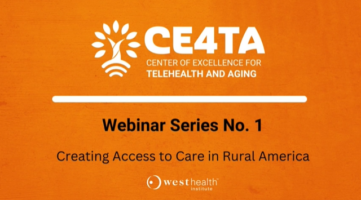In this webinar, Dr. Kristin Rising, Professor and Executive Director of the Center for Connected Care at Thomas Jefferson University, and Frank Sites, Vice President of Connected Care Operations at Jefferson Health, presented strategies for supporting digital health readiness across the care continuum for aging populations. The session featured a panel discussion with AARP California State President Joe Garbanzos, who shared valuable insights for advancing digital health readiness.
This implementation guide offers practical solutions for delivering age-inclusive telehealth services in post-acute and long-term care settings. It ensures that telehealth practices are person-centered, equitable, integrated, and coordinated to meet the unique needs of older adults. The guide includes valuable tools such as use cases, workflows, communication strategies, training approaches, and performance metrics.

In this webinar, Dr. Linda DeCherrie, Vice President of Clinical Strategy and Implementation at Medically Home, provided an in-depth overview of the Hospital at Home (HAH) model, highlighting the key role it plays in delivering safe, effective, and patient-centered care to older adults. The session featured a panel discussion with Dr. Bruce Leff (Johns Hopkins) and Rani Snyder (John A. Hartford Foundation), who shared strategies for improving healthcare accessibility and tailoring care to address the unique needs of older adults.

In this webinar, Rebecca Harless, Vice President of CAMC Greenbrier Valley Medical Center in West Virginia, presented strategies for establishing telemedicine hubs to ensure access to care in rural communities. The session also featured a panel discussion with experts in telehealth, geriatric care, and rural health, offering valuable insights to improve healthcare delivery in these critical areas.
Review that describes a new interprofessional community-service learning program geared towards improving older adults’ attitudes about telehealth.
Review that describes how older adults with chronic kidney disease, their caregivers, and their clinicians perceive telehealth encounters and ultimately discusses that greater resources are needed to support older adults with chronic illness, limited English proficiency, hearing loss, and limited access to technology.
Review that describes a telehealth intervention and its effects on the activity profiles of older adults. Older adults benefit from support transitioning to telehealth.
Review that describes a feasibility pilot study for older adults that addresses the digital divide, unmet health care needs, and the 4Ms of Age-Friendly Health Systems.
Review that proposes the Telehealth Literacy Screening Tool (TLST) as a means of identifying geriatric patients in need of connection to telehealth services.
Making changes to the way care is delivered often requires a champion who will lead the way. Here are some tips for engaging a champion.
PDSA Planning & Progress Form
Enacting policy or procedure improvements within a healthcare system is vital for ensuring that the institution remains on the forefront of providing high- quality care. It is critical that quality improvement measures encourage systematic behavior to reduce variability and achieve predictable results1. To best ensure a smooth transition, the Associates for Process Improvement (API) developed The Model for Improvement.
